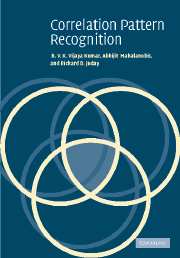Book contents
6 - Advanced correlation filters
Published online by Cambridge University Press: 06 August 2009
Summary
Ever since VanderLugt's pioneering work [5] on the implementation of matched filters (MFs) by coherent optical processing, there has been considerable interest in using correlators for recognizing patterns in images. The MF is of course optimal for finding a given pattern in the presence of additive white noise, and, as we have shown in Chapter 5, yields the highest output SNR. In radar signal processing and digital communications, matched filters have been very successful in many applications. For image processing, perhaps the greatest appeal of correlation filtering lies in its ability to produce shift-invariant peaks (because correlation filters are just a special class of LSI filter) and the resultant processing simplicity since we can avoid the need for image segmentation and registration. Unfortunately, MFs are not adequate for practical pattern recognition since their response degrades rapidly when the patterns deviate from the reference [57]. Such pattern variations can be induced by scale changes, rotations or signature differences, all of which are common phenomena associated with the general pattern recognition problem.
One straightforward approach to this problem would be to apply a large number of MFs, each tuned to a particular variation. However, the enormous storage and processing requirements of this approach make it impractical. The alternative is to design robust correlation filters that can overcome the limitations of the MFs.
- Type
- Chapter
- Information
- Correlation Pattern Recognition , pp. 196 - 243Publisher: Cambridge University PressPrint publication year: 2005



